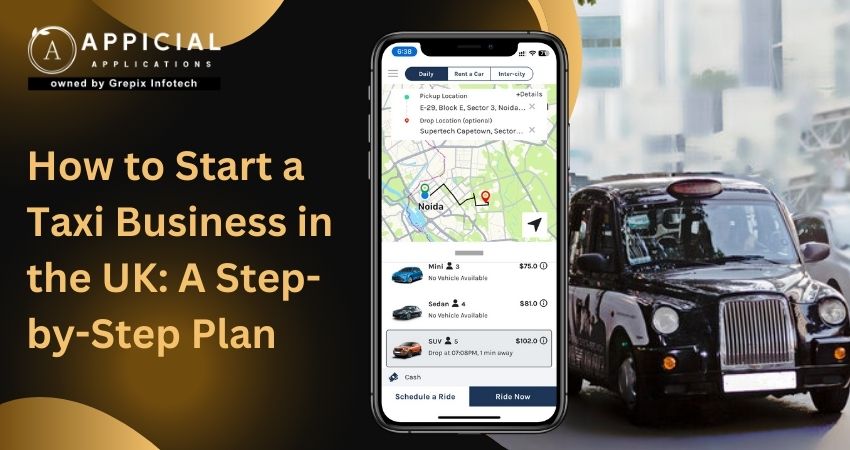
How to Start a Taxi Business in the UK: A Step-by-Step Plan
Starting a taxi business in the UK can be a lucrative venture if approached strategically. From understanding the legal landscape to equipping your fleet with the latest technology, every step plays a crucial role in building a successful operation. With careful planning and a customer-first approach, you’ll be well on your way to creating a thriving taxi service.
The taxi industry in the UK is a cornerstone of transportation, offering reliable, flexible travel options to millions of people. Whether it’s a quick ride to work or a longer trip to the airport, the demand for taxi services remains robust. This blog outlines the essential steps to help you launch a thriving taxi business in the UK.
Starting a taxi business in the UK can be highly profitable with the right approach. The industry’s steady growth, fueled by increasing urbanization and app-based services, presents significant opportunities for entrepreneurs. Success hinges on thorough planning, including understanding the market, adhering to legal requirements, and equipping your fleet with essential technology. Developing a solid business plan, setting competitive pricing, and leveraging modern booking systems are vital. By focusing on customer satisfaction, safety, and scalability, aspiring taxi operators can build a thriving business in this competitive sector. With careful execution, your venture can become a trusted transportation service for local communities.
How To Start a Taxi Business in UK: Step-by-Step
1 Understanding the UK Taxi Industry
Types of Taxi Services in the UK
The UK taxi industry comprises two main types of services:
- Public Hire Taxis: These are the iconic black cabs that can be hailed directly on the street.
- Private Hire Vehicles (PHVs): These must be booked in advance and include minicabs and app-based services like Uber.
Each type has unique requirements and opportunities, so understanding which aligns with your business goals is crucial.
Key Statistics and Growth Trends
The UK taxi market has grown significantly, with the ride-hailing sector alone expected to hit £10 billion by 2025. This growth is fueled by increasing urbanization and a shift toward app-based bookings, making it a promising industry for entrepreneurs.
2 Creating a Business Plan
Importance of a Business Plan
A solid business plan is the foundation of a successful taxi business. It provides clarity, sets realistic goals, and serves as a roadmap to guide your operations.
Components of a Taxi Business Plan
- Market Research: Analyze your target audience, competitors, and demand in your area.
- Financial Projections: Outline start-up costs, revenue streams, and profit margins.
- Operational Plan: Detail daily processes, including booking, dispatch, and customer service.
3 Choosing a Business Model
Operating as an Independent Driver
This model is ideal for those who prefer a simple setup. You’ll need your vehicle and the necessary licenses.
Running a Fleet of Vehicles
Managing a fleet involves higher investment but offers greater revenue potential. You’ll need multiple vehicles and drivers to scale operations.
Partnering with Ride-Hailing Apps
Apps like Uber and Bolt offer an established customer base, making them an excellent option for new entrants. However, they charge commissions on bookings.
4 Registering Your Taxi Business
Legal Structures for a Taxi Business
Choose the structure that best suits your needs:
- Sole Trader: Simple and cost-effective but offers limited liability protection.
- Partnership: Shared responsibilities and profits among partners.
- Limited Company: Offers liability protection but involves more paperwork.
Registering with HMRC
All businesses must register with HMRC for tax purposes. This step ensures you comply with legal obligations and avoid penalties.
To legally operate a taxi business in the UK, securing a taxi operator license is essential. This license is issued by your local council and varies depending on whether you run a private hire service or public hire (black cab). Ensure that:
- All required documentation is in order, including proof of identity and financial stability.
- Your premises meet local council regulations for operating a taxi business.
Vehicle Licensing Requirements
Each vehicle in your fleet must meet licensing standards set by your local council. These typically include:
- Vehicles being under a certain age (e.g., 10 years old or less).
- Passing a council-approved MOT or vehicle inspection.
- Displaying a valid taxi plate and signage.
Driver Licensing Requirements
Every driver in your business must hold a valid taxi or private hire driver's license. This involves:
- Passing a Disclosure and Barring Service (DBS) check for criminal records.
- Completing a medical fitness examination.
- Demonstrating knowledge of local routes and areas, often through a knowledge test.
5 Purchasing and Equipping Your Vehicles
Choosing the Right Vehicles for Your Fleet
Investing in reliable, fuel-efficient vehicles is crucial for long-term success. When selecting vehicles:
- Consider passenger comfort, luggage space, and accessibility features.
- Opt for hybrid or electric cars to reduce running costs and meet environmental standards.
Vehicle Insurance and MOT Tests
Taxi vehicles require specialized insurance, covering both private hire and public hire operations. Ensure:
- Your insurance includes public liability and employer's liability (if applicable).
- All vehicles undergo regular MOT checks to maintain roadworthiness and comply with legal standards.
Installing Taxi Meters and Other Essentials
Equip each vehicle with essential tools, such as:
- Taxi Meters: To calculate fares accurately.
- GPS Devices: For navigation and tracking.
- Dashcams: To enhance safety and provide evidence in case of disputes.
6 Setting Up Your Technology
Taxi Dispatch Systems
A taxi dispatch system streamlines bookings and ensures efficiency. Modern systems allow for:
- Real-time tracking of vehicles.
- Automatic assignment of bookings to the nearest driver.
- Seamless communication between drivers and the control center.
GPS Tracking and Navigation Tools
Invest in reliable GPS systems to optimize routes and reduce fuel consumption. Many systems also provide traffic updates, helping drivers avoid delays.
Online Booking and Payment Systems
Incorporate user-friendly booking and payment platforms to attract tech-savvy customers. Features to include:
- Mobile apps for easy bookings.
- Multiple payment options, including card payments and digital wallets.
- Automatic fare calculation and e-receipts.
7 Marketing Your Taxi Business
Creating a Brand Identity
Developing a strong brand identity helps you stand out in a competitive market. This includes:
- A memorable business name and logo.
- Consistent branding on vehicles and marketing materials.
Advertising Strategies
Promote your taxi business through multiple channels:
- Social Media: Use platforms like Facebook and Instagram to target local customers.
- Flyers and Posters: Distribute in busy areas such as train stations, airports, and shopping centers.
- Partnerships: Collaborate with hotels, restaurants, and event venues for mutual promotion.
Leveraging Customer Reviews
Positive reviews can significantly boost your reputation. Encourage satisfied customers to leave reviews on platforms like Google or Trustpilot.
8 Hiring and Training Drivers
Recruiting Qualified Drivers
Hiring competent drivers is crucial for customer satisfaction and safety. When recruiting:
- Look for individuals with clean driving records and valid licenses.
- Conduct thorough background checks to ensure reliability.
Training in Customer Service
Train drivers to provide excellent service by focusing on:
- Communication skills and polite behavior.
- Handling complaints professionally.
- Assisting passengers with special needs or disabilities.
Ensuring Driver Safety
Implement measures to safeguard drivers, such as:
- Providing training on defensive driving.
- Equipping vehicles with safety tools like panic buttons and dashcams.
9 Setting Pricing and Payment Options
Competitive Pricing Strategies
Pricing is one of the most critical aspects of running a taxi business. To set competitive rates:
- Research your competitors’ pricing structures.
- Consider the costs of operation, including fuel, insurance, and maintenance.
- Offer flat rates for common routes, such as airport transfers, to attract more customers.
Offering discounts for regular customers or introducing loyalty programs can also help you stand out.
Payment Methods
In today’s cashless society, flexibility in payment options is key. Ensure your business accepts:
- Cash Payments: Still preferred by some customers.
- Card Payments: Through mobile point-of-sale (POS) devices.
- Digital Wallets: Popular apps like Apple Pay, Google Pay, and PayPal.
- App-Based Payments: Integrate your payment system with your booking app for seamless transactions.
Also Read: Top 10 Ride-hailing Taxi Apps in the United Kingdom
10 Managing Finances and Taxes
Opening a Business Bank Account
Managing finances and taxes is crucial for the success of your taxi business. Open a dedicated business bank account to separate personal and business transactions. Keep detailed financial records, use accounting software to track income and expenses, and stay compliant with tax obligations like VAT, income tax, and National Insurance.
Consulting an accountant can simplify the process and help you avoid costly mistakes.
11 Ensuring Safety and Compliance
Health and Safety Standards
Your taxi business must adhere to strict health and safety standards to protect passengers and drivers. Key measures include:
- Regular vehicle maintenance to avoid breakdowns.
- Cleaning and sanitizing vehicles daily, especially in light of COVID-19 concerns.
- Equipping vehicles with fire extinguishers and first-aid kits.
Handling Complaints and Disputes
A robust complaint resolution system builds trust with your customers. To manage issues effectively:
- Train drivers to handle complaints calmly and professionally.
- Offer multiple channels for customers to provide feedback, such as email, phone, or an online form.
- Respond to complaints promptly and work toward fair resolutions.
12 Scaling Your Taxi Business
Adding More Vehicles to Your Fleet
Expanding your fleet is a natural step when demand increases. To do this:
- Monitor your business’s financial health to determine when to invest.
- Lease or purchase additional vehicles, ensuring they meet licensing requirements.
- Consider adding eco-friendly vehicles to attract environmentally conscious customers.
Expanding to New Areas
To grow your customer base, explore opportunities in neighboring towns or cities. Research local demand and adjust your marketing efforts to target the new area effectively.
Diversifying Services
Diversifying your services can help increase revenue streams. Popular options include:
- Airport transfers with flat-rate pricing.
- Executive services with luxury vehicles.
- Parcel delivery services for businesses or individuals.
Conclusion
Appicial Applications, a leading taxi app development company, understands the immense potential of the UK’s thriving taxi industry. Whether targeting bustling urban areas or local markets, starting a taxi business in the UK offers a lucrative opportunity to serve a diverse and growing customer base. By leveraging Appicial’s cutting-edge taxi app solutions, you can streamline operations, enhance customer satisfaction, and stay competitive in this dynamic market.
From integrating advanced booking systems to adopting sustainable practices, Appicial provides the tools and expertise to help you succeed. Partner with Appicial today to transform your vision into a modern, thriving taxi business in the UK.
FAQs
Looking out to start your own venture like Uber ? Try out our HireMe Taxi Uber Clone, the easiest way to kick-start your taxi business.
Author's Bio

Vinay Jain is the Founder at Grepix Infotech and brings over 12 years of entrepreneurial experience. His focus revolves around software & business development and customer satisfaction.
Back to blog list






